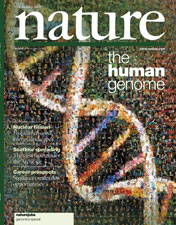What a long, strange trip
it's been. . .
URL: http://www.nature.com/cgi-taf/DynaPage.taf?file=/nature/journal/v409/n6822/full/409756a0_fs.html
Date accessed: 25 February 2001
Nature 409,
756 - 757 (2001) © Macmillan Publishers Ltd.
 15
February 2001
15
February 2001
The draft human genome
sequence published in Nature this week is the culmination of 15 years of
work, involving 20 sequencing centres in six countries. Here, we present a
reminder of some of the key moments.
1985
In 1985, Charles DeLisi, then associate director for health and environmental
research at the Department of Energy (DoE), begins to discuss a mammoth project
— of a scale unprecedented in biology — to sequence the complete human
genome. DoE funding begins in 1987.
1988
The National Institutes of Health (NIH) establishes the Office of Human Genome
Research in September 1988. Renamed the National Center for Human Genome
Research (NCHGR) a year later, its director is James Watson, co-discoverer of
the double helix structure of DNA. Watson's testimony to the US Congress, in
which he pledged to devote a small fraction of the project's budget to 'ethical,
legal and social' issues, had proved instrumental in garnering political
support.
Early 1990s
With sequencing still slow and expensive, the genome projects adopts a
'map-first, sequence-later' strategy. In the early 1990s, two Parisian
laboratories, the Centre d'Etude du Polymorphisme Humain and Généthon, have an
integral role in mapping — underlining the project's international character.
The labs' driving forces are Daniel Cohen (top) and Jean Weissenbach. Later, the
genome project constructs a higher-resolution map that is used to sequence and
assemble the human genome.
1992
Francis Collins of the University of Michigan replaces Watson as head of NCHGR
in April 1992. Watson had earlier clashed with Craig Venter, then at NIH, over
the patenting of DNA fragments known as expressed sequence tags.
1992
Later that year, Venter sets up The Institute for Genomic Research (TIGR) in
Rockville, Maryland. TIGR later sequences a host of bacterial genomes, starting
with Haemophilus influenzae.
1996
In February 1996, at a meeting in Bermuda, international partners in the genome
project agree to formalize the conditions of data access, including release of
sequence data into public databases within 24 hours. These came to be known as
the 'Bermuda principles'.
1998
In May 1998, Venter forms a company to sequence the human genome within three
years. The company, later named Celera, will use an ambitious 'whole genome
shotgun' method, which involves assembling the genome without using maps. But
its data release policy will not follow the Bermuda principles.
1999
The public project responds to Venter's challenge. By early 1999, it is on track
to produce a draft genome sequence by 2000. Increasingly, the bulk of the
sequencing takes place in five huge centres: at the Whitehead Institute for
Biomedical Research in Cambridge, Massachusetts; the Sanger Centre near
Cambridge, UK; Baylor College of Medicine in Houston; Washington University in
St Louis; and the DoE's Joint Genome Institute (JGI) in Walnut Creek,
California. The centres' leaders are dubbed the 'G5'. Here, Robert Waterston of
Washington University in St Louis and John Sulston of the Sanger Centre are
pictured in a rare moment of relaxation, while Trevor Hawkins and Elbert
Branscomb of the JGI prepare samples.
1999-2000
The first complete human chromosome sequence — number 22 — is published in
December 1999. Chromosome 21 follows in May 2000, a collaborative effort led by
German and Japanese groups under the direction of André Rosenthal and Yoshiyuki
Sakaki, respectively. Sakaki (centre) is pictured here at Nature's
chromosome 21 press conference in Tokyo.
2000
On 26 June 2000, leaders of the public project and Celera announce completion of
a working draft of the human genome sequence. Collins and Venter are seen here
on television with Ari Patrinos of the DoE, who cut through the animosity
between the rival projects to broker the joint announcement at the White House
in Washington.
Outside, celebrations continue with Eric Lander of the Whitehead Institute,
Baylor's Richard Gibbs, and Waterston and Richard Wilson from Washington
University.
This week
Finally, this week sees the publication of the draft genome, the public sequence
in Nature, Celera's in Science.
Super models
The complete genome sequences of model organisms are proving immensely valuable
to biologists working on these species, and will also help interpret the human
genome sequence. Published highlights to date include the yeast Saccharomyces
cerevisiae (May 1997), the nematode Caenorhabditis elegans (December
1998), the fruitfly Drosophila melanogaster (March 2000, right), and the
plant Arabidopsis thaliana (December 2000, left).
Technical gurus
Without advances in sequencing technology, we would still be waiting to unveil
our genetic blueprint. Double Nobel laureate Fred Sanger (pictured) of the
Laboratory of Molecular Biology in Cambridge invented the basic technique of
gene sequencing back in the 1970s. In the 1980s, Leroy Hood, then at the
California Insitute of Technology in Pasadena, introduced the first automated
sequencing machine. But it was the ABI PRISM 3700 DNA Analyzer, developed by
Michael Hunkapiller of PE Biosystems, which allowed the rapid sequencing
progress made by both Celera and the public project over the past two years.
Assembling fragments of the genome into a complete sequence, meanwhile, depended
heavily on computer programs developed by Philip Green of the University of
Washington in Seattle.
We are grateful for contributions and input from Francis Collins, Richard
Gibbs, Victor McKusick, John McPherson, David Stewart and the staff of the Cold
Spring Harbor Laboratory.
PHOTOGRAPHY IN THIS ARTICLE: PETER MENZEL/SPL, STEVE MUREZ/RAPHO/NETWORK,
CHRISTIAN VIOUJARD/FRANK SPOONER, RAPHAEL GAILLARDE/FRANK SPOONER, ROBERT
HARDING, J. BERGER/T. LAUX/E. MEYEROWITZ, LIAISON, NIKKAN KOGYO SHIMBUN, JAMES
KING-HOLMES/SPL.
 Nature
© Macmillan Publishers Ltd 2001 Registered No. 785998 England.
Nature
© Macmillan Publishers Ltd 2001 Registered No. 785998 England.
Category: 32. Genome
Project and Genomics
![]() 15
February 2001
15
February 2001













